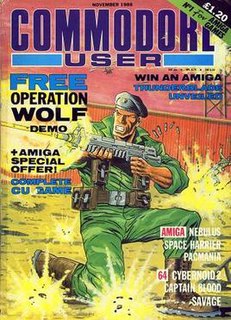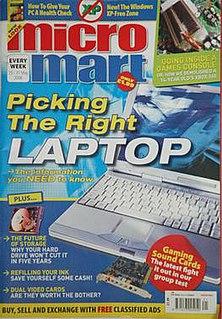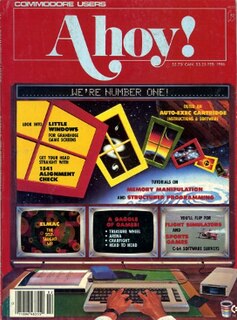External links
| This computer magazine or journal-related article is a stub. You can help Wikipedia by expanding it. See tips for writing articles about magazines. Further suggestions might be found on the article's talk page. |
It is proposed that this article be deleted because of the following concern:
If you can address this concern by improving, copyediting, sourcing, renaming, or merging the page, please edit this page and do so. You may remove this message if you improve the article or otherwise object to deletion for any reason. Although not required, you are encouraged to explain why you object to the deletion, either in your edit summary or on the talk page. If this template is removed, do not replace it . The article may be deleted if this message remains in place for seven days, i.e., after 18:51, 15 May 2020 (UTC). Nominator: Please consider notifying the author/project: {{subst:proposed deletion notify |Amazing Computing|concern=Uncited and seemingly non-notable. I can't find any sources that demonstrate anything other than its existence.}} ~~~~ |
Amazing Computing was a computer magazine devoted to the Amiga computer. It was published by PiM Publications of Fall River, Massachusetts, United States, from 1985 to (sporadically) 1999. Other Amiga publications from PiM include AC's Tech for the Amiga and AC's Guide . The publisher was Don Hicks.
A frequent column in Amazing Computing was "Roomers" by "the Bandito" which offered unsourced rumors, speculation, and inside information regarding developments on the AMIGA scene. These often involved internal problems at Commodore Business Machines, the makers of the Amiga, and the alleged mismanagement of the company by its executives.
The identity of "the Bandito" was never revealed although the publishers did hint that the writer had actually been several different people over the years. The column was discontinued after the demise of Commodore.
Additional filler was provided by a complete listing of the Fred Fish disks.
| This computer magazine or journal-related article is a stub. You can help Wikipedia by expanding it. See tips for writing articles about magazines. Further suggestions might be found on the article's talk page. |

The Commodore 64, also known as the C64 or the CBM 64, is an 8-bit home computer introduced in January 1982 by Commodore International. It has been listed in the Guinness World Records as the highest-selling single computer model of all time, with independent estimates placing the number sold between 10 and 17 million units. Volume production started in early 1982, marketing in August for US$595. Preceded by the Commodore VIC-20 and Commodore PET, the C64 took its name from its 64 kilobytes(65,536 bytes) of RAM. With support for multicolor sprites and a custom chip for waveform generation, the C64 could create superior visuals and audio compared to systems without such custom hardware.

Commodore International was an American home computer and electronics manufacturer founded by Jack Tramiel. Commodore International (CI), along with its subsidiary Commodore Business Machines (CBM), participated in the development of the home–personal computer industry in the 1970s and 1980s. The company developed and marketed the world's best-selling desktop computer, the Commodore 64 (1982), and released its Amiga computer line in July 1985. With quarterly sales ending 1983 of $49 million, Commodore was one of the world's largest personal computer manufacturers.

Commodore User, known to the readers as the abbreviated CU, was one of the oldest British Commodore magazines. A publishing history spanning over 15 years, mixing content with technical and video game features. Incorporating Vic Computing in 1983 by publishers EMAP, the magazine's focus moved to the emerging Commodore 64, before introducing Amiga coverage in 1986, paving the way for Amiga's dominance and a title change to CU Amiga in 1990. Covering the 16-bit computer, the magazine continued for another eight years until the last issue was published in October 1998 when EMAP opted to close the magazine due to falling sales and a change in focus for EMAP. The magazine also reviewed arcade games.
Draco was a shareware programming language created by Chris Gray. First developed for CP/M systems, Amiga version followed in 1987.

Temple of Apshai is a dungeon crawl role-playing video game developed and published by Automated Simulations in 1979. Originating on the TRS-80 and Commodore PET, it was followed by several updated versions for other computers between 1980 and 1986.

Compute!, often stylized as COMPUTE!, was an American home computer magazine that was published from 1979 to 1994. Its origins can be traced to 1978 in Len Lindsay's PET Gazette, one of the first magazines for the Commodore PET computer. In its 1980s heyday Compute! covered all major platforms, and several single-platform spinoffs of the magazine were launched. The most successful of these was Compute!'s Gazette, which catered to VIC-20 and Commodore 64 computer users.
The Pawn is a text-based interactive fiction game by Magnetic Scrolls, first published for the Sinclair QL by Sinclair Research in 1985. It was then released for other platforms in 1986 by Rainbird. It is remembered for its excellent graphics and the opening music available in some game versions. Also the game itself—story and parser—got mostly positive reviews. The story takes place in the fairy land of Kerovnia, from which the player must escape.

Compute!'s Gazette, stylized as COMPUTE!'s Gazette was a computer magazine of the 1980s, directed at users of Commodore's 8-bit home computers. Announced as The Commodore Gazette, the Gazette was a Commodore-only daughter magazine of the computer hobbyist magazine Compute!. It was first published in July 1983.
Aladdin4D is a computer program for modeling and rendering three-dimensional graphics and animations, currently running on AmigaOS and macOS platforms. A-EON Technology Ltd owns the rights and develops current and future versions of Aladdin4D for AmigaOS, MorphOS & AROS. All other platforms including macOS, iPadOS, iOS, Linux & Windows are developed by DiscreetFX.

Micro Mart was a weekly computer magazine published in the United Kingdom by Dennis Publishing Ltd.. As of 2015, it had a circulation of 5,422. In a letter to subscribers in December 2016 it was announced that the magazine would cease publication with issue No 1445 : "After 30 amazing years of telling it like it is, Micro Mart magazine is logging off."
Europress was a British magazine and software publisher based in Adlington, near Macclesfield, Cheshire. Their magazine publishing business was previously known as Database Publications.

.info was a computer magazine covering Commodore 8-bit computers and later the Amiga. It was published from 1983 to 1992.

Ahoy! was a computer magazine published between January 1984 and January 1989 that focused on all Commodore International color computers, but especially the Commodore 64 and Amiga. It was noted for the quality and learnability of its type-in program listings.

Home computers were a class of microcomputers that entered the market in 1977 and became common during the 1980s. They were marketed to consumers as affordable and accessible computers that, for the first time, were intended for the use of a single nontechnical user. These computers were a distinct market segment that typically cost much less than business, scientific or engineering-oriented computers of the time such as the IBM PC, and were generally less powerful in terms of memory and expandability. However, a home computer often had better graphics and sound than contemporary business computers. Their most common uses were playing video games, but they were also regularly used for word processing, doing homework, and programming.

Rashumon was a multilingual graphical word processor developed for the Amiga computer by an Israel-based company called HarmonySoft and was sold until after the demise of Commodore in 1994. Rashumon had particular support for Hebrew, Arabic and Russian as well as English, and it could send its text to speech synthesis in English.
Commodore Computing International was a magazine for the Commodore range of computers, including the Commodore 64, Amiga, and Commodore PC range.

The Transactor was a computer magazine directed at users of Commodore home computers.

World of Commodore is an annual computer expo dedicated to Commodore computers.